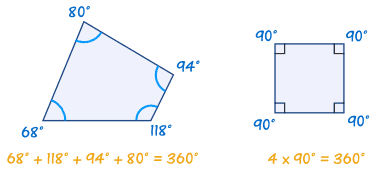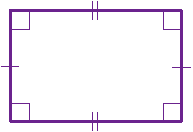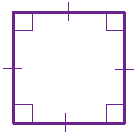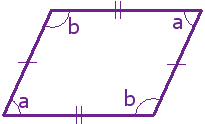A quadrilateral, also known as tetragon or quadrangle, is a general term for a four sided polygon.
In fact, there are six types of quadrilaterals. They are square, parellelogram, rectangle, rhombus, trapezoid and trapezium. Each of these six quadrilaterals has special qualities which be discussed in the succeeding parts of this section.
The common parts of a quadrilateral are described as follows.
1. Sides: these are line segments joining any two adjacent vertices (corners).
2. Interior angles: an interior angle is the angle formed between two adjacent sides.
3. Height or altitude: it is the distance between two parallel sides of a quadrilateral.
4. Base: this is the bottom side that is perpendicular to the altitude.
5. Diagonal: this is the line segment joining any twi non-adjacent vertices.
Classifications
The classification of quadrilaterals is based on the number of pairs of its parallel sides.
1. Parallelogram has two pairs of parallel sides.
2. Trapezoid has only one pair of parallel sides.
3. Trapezium does not have any pair of parallel sides.
4. Rectangle, rhombus and square are special types of parallelograms.
Properties
A quadrilateral has:
- four sides (edges)
- four vertices (corners)
- interior angles that add to 360 degrees:

Try drawing a quadrilateral, and measure the angles. They should add to 360°
Types of Quadrilaterals
There are special types of quadrilateral:

The Rectangle
 | |||
| means "right angle" | |||
| show equal sides | |||
A rectangle is a four-sided shape where every angle is a right angle (90°).
Also opposite sides are parallel and of equal length.
The Rhombus

A rhombus is a four-sided shape where all sides have equal length.
Also opposite sides are parallel and opposite angles are equal.
Another interesting thing is that the diagonals (dashed lines in second figure) meet in the middle at a right angle. In other words they "bisect" (cut in half) each other at right angles.
A rhombus is sometimes called a rhomb or a diamond.
The Square
 | |||
| means "right angle" | |||
| show equal sides | |||
A square has equal sides and every angle is a right angle (90°)
Also opposite sides are parallel.
A square also fits the definition of a rectangle (all angles are 90°), and a rhombus (all sides are equal length).
The Parallelogram

A parallelogram has opposite sides parallel and equal in length. Also opposite angles are equal (angles "a" are the same, and angles "b" are the same).
The Trapezoid (UK: Trapezium)
 |  | |
Trapezoid
|
Isosceles Trapezoid
|
A trapezoid (called a trapezium in the UK) has a pair of opposite sides parallel.
And a trapezium (called a trapezoid in the UK) is a quadrilateral with NO parallel sides:
| Trapezoid | Trapezium | |
| In the US: | a pair of parallel sides | NO parallel sides |
| In the UK: | NO parallel sides | a pair of parallel sides |
| (the US and UK definitions are swapped over!) | ||
An Isosceles trapezoid, as shown above, has left and right sides of equal length that join to the base at equal angles.
The Kite

Hey, it looks like a kite (usually).
It has two pairs of sides:
Each pair is made of two equal-length sides that join up.
Also:
- the angles where the two pairs meet are equal.
- the diagonals, shown as dashed lines above, meet at a right angle.
- one of the diagonals bisects (cuts equally in half) the other.
Irregular Quadrilaterals
The only regular (all sides equal and all angles equal) quadrilateral is a square. So all other quadrilaterals are irregular.
The "Family Tree" Chart
This may seem odd, as in daily life we think of a square as not being a rectangle ... but in mathematics it is.
Using the chart below we can answer such questions as:
- Is a Square a type of Rectangle? (Yes)
- Is a Rectangle a type of Kite? (No)

Complex Quadrilaterals
Oh Yes! when two sides cross over, we call it a "Complex" or "Self-Intersecting" quadrilateral, like these:

They still have 4 sides, but two sides cross over.
Polygon
A quadrilateral is a polygon. In fact it is a 4-sided polygon, just like a triangle is a 3-sided polygon, a pentagon is a 5-sided polygon, and so on.
Play with Them
Now that you know the different types, you can play with the Interactive Quadrilaterals.
Other Names
A quadrilateral can sometimes be called:
- a Quadrangle ("four angles"), so it sounds like "triangle"
- a Tetragon ("four and polygon"), so it sounds like "pentagon", "hexagon", etc.



No comments:
Post a Comment